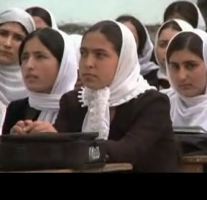 Empowering women is critical to improving life in Afghanistan and key to a brighter future there. Last week the Obama administration unveiled a plan to do just that.
Empowering women is critical to improving life in Afghanistan and key to a brighter future there. Last week the Obama administration unveiled a plan to do just that.
The Women’s Action Plan for Afghanistan, outlined by Secretary of State Hillary Rodham Clinton at the London Conference on Afghanistan on January 28, seeks to increase Afghan women’s security, leadership in the public and private sectors, access to judicial institutions, education and health services, and ability to take advantage of economic opportunities, especially in the agricultural sector.
The number of girls being educated in Afghanistan has improved dramatically, with girls making up about 35 percent of the 6.2 million students now enrolled in Afghan schools. Under Taliban rule, fewer than 900,000 boys — and no girls — were enrolled.
Since 2001, the U.S. Agency for International Development (USAID) has repaired or built more than 670 schools and improved the qualifications of 54,000 Afghan teachers. U.S. government assistance has extended to 18 provinces and more than 43,000 children, of whom 60 percent are girls. The United States hopes to work with the Afghan government to further expand these programs.
 But more remains to be done. Violence by the Taliban has created fear among girls who want to go to school. U.S. assistance programs are providing greater protection for girls’ schools and health facilities., by building walls around some schools, providing better training for the Afghan National Police and National Army, and even bringing more women in as police officers. The United States has helped train more than 500 female police officers since 2003.
But more remains to be done. Violence by the Taliban has created fear among girls who want to go to school. U.S. assistance programs are providing greater protection for girls’ schools and health facilities., by building walls around some schools, providing better training for the Afghan National Police and National Army, and even bringing more women in as police officers. The United States has helped train more than 500 female police officers since 2003.
The overall U.S. funding strategy includes a push to make sure women’s rights are protected by Afghan justice systems. It also seeks to increase women’s participation in local and national politics, as well as their involvement in traditional systems of governance, such as local shuras (community leadership consultations).
Women are drivers of economic growth. According to the State Department, they typically invest up to 90 percent of their earnings in their families and communities — twice the rate for men. Getting more Afghan women into the work force — especially into agriculture, the country’s main income-producing industry — is a top U.S. priority.
Because more than 80 percent of the Afghan people earn their income from agriculture, U.S. aid is aimed at increasing women’s participation in that segment of the work force while increasing the productivity of the land available for farming. Women are being trained in agricultural production, animal husbandry, veterinary medicine and poultry breeding. Small loans are being made available to help Afghan women start their own businesses based on agriculture, as well as small businesses based on handicrafts and clothing.
“Women and girls, who are one of the world’s greatest untapped resources,” Clinton “and deserve our investment in their potential.”In a January 29 statement, the State Department said the Afghan government is also taking “important steps” toward improving the lot of women. It has committed to enacting legislation to eradicate violence against women and has recognized the importance of women in both its Afghan National Development Strategy and the National Action Plan for the Women of Afghanistan.
More info can be found here at the State Department website.
(Story by America.gov)



















